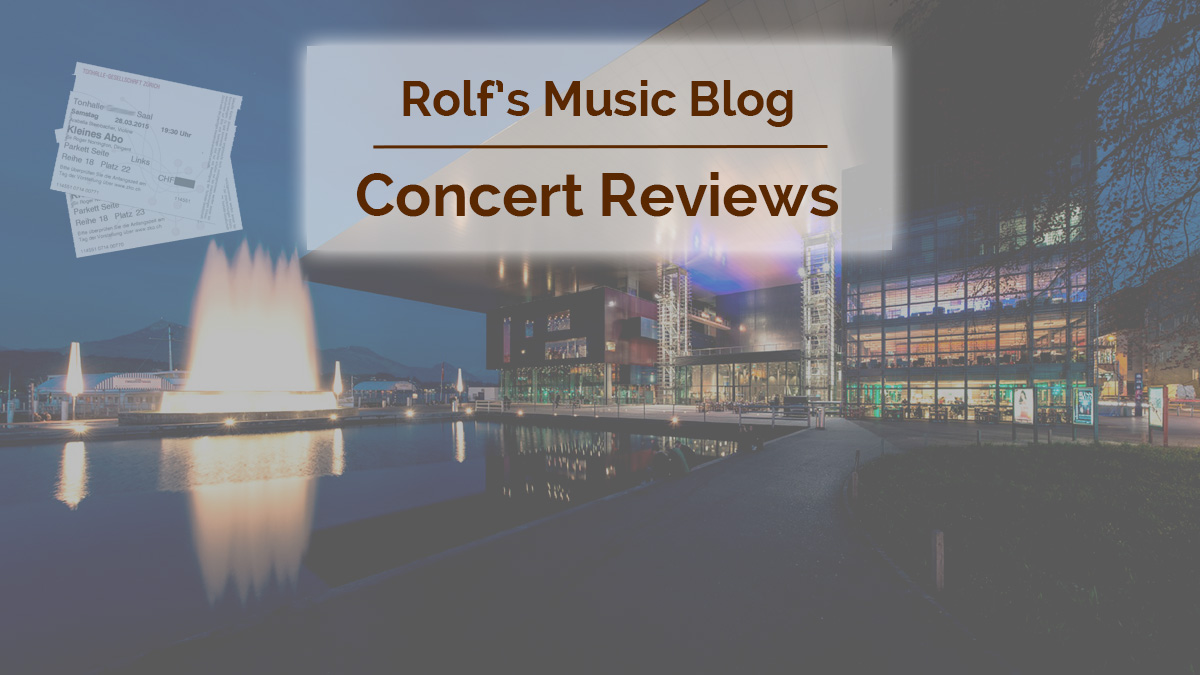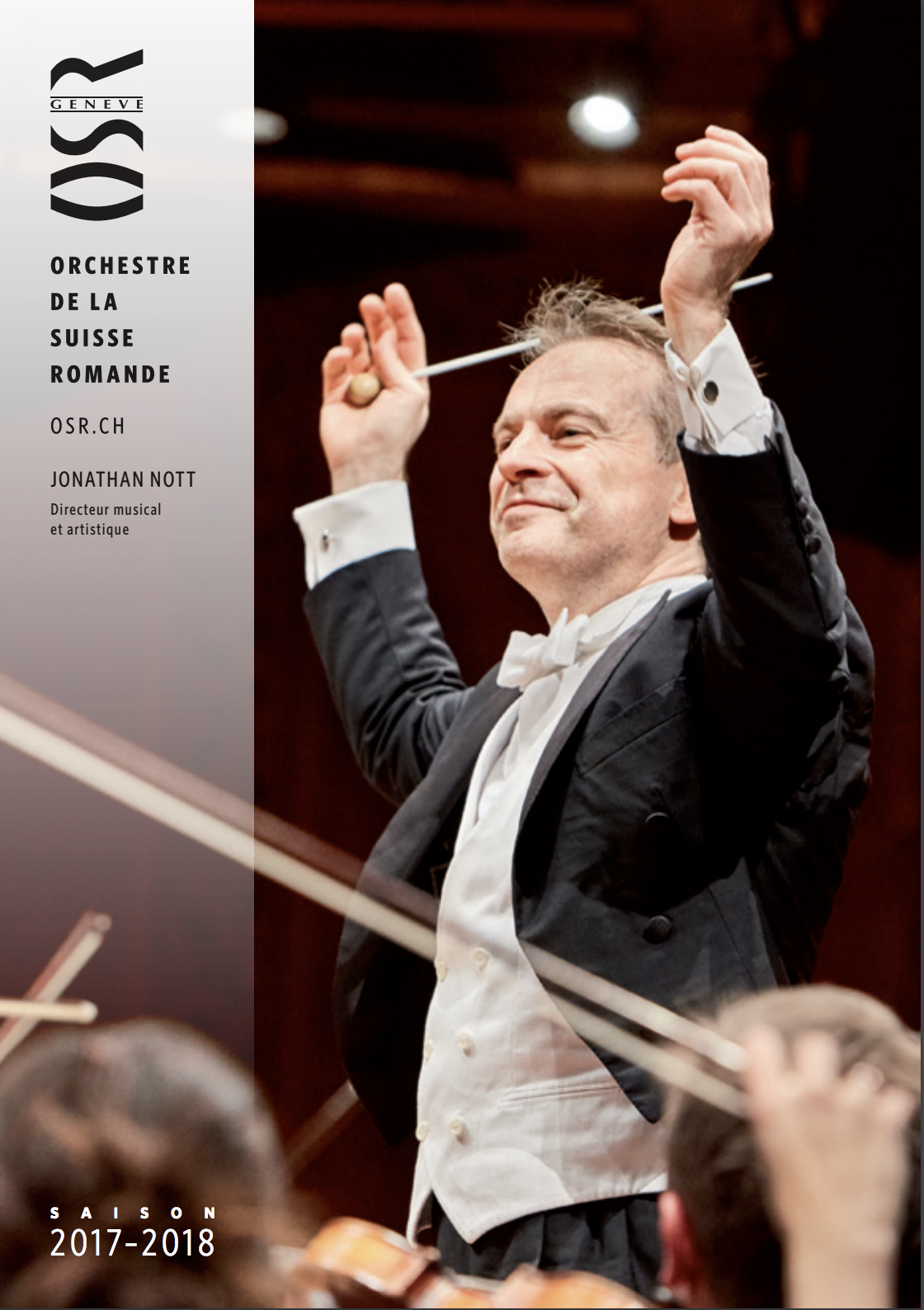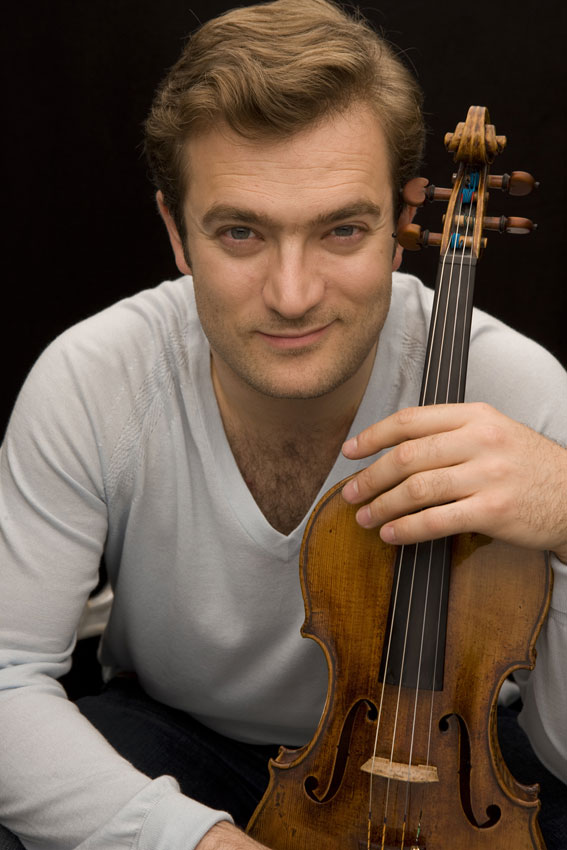Renaud Capuçon, Jonathan Nott / OSR
Debussy / Sibelius / Strauss
KKL, Lucerne Festival, 2018-08-19

2018-09-24 — Original posting
Spiel, Wärme und Süße: Renaud Capuçon und Jonathan Nott mit dem OSR am Lucerne Festival — Zusammenfassung
Das Orchestre de la Suisse Romande feierte sein 100-jähriges Bestehen in einem Konzert am Lucerne Festival, unter seinem Dirigenten Jonathan Nott. Zwischen Ballettmusik von Claude Debussy und Richard Strauss spielte Renaud Capuçon das Solo im Violinkonzert von Jean Sibelius. Er gestaltete vor allem den langsamen Mittelsatz zu einem intensiven, anrührenden Höhepunkt.
Table of Contents
Introduction
One of the first concerts in this year’s Lucerne Festival was the late matinée / lunch-time concert with the Orchestre de la Suisse Romande (OSR). This event celebrated two anniversaries: 1918, 100 years ago, the Swiss conductor Ernest Ansermet (1883 – 1969) founded the OSR. 20 years later, the orchestra and its founder played a key role in the creation of the Lucerne Festival, which therefore now celebrates its 80th anniversary.
Ernest Ansermet led the OSR for 49 years. In 1967, Paul Kletzki (1900 – 1973) took over the position of music director, succeeded 1972 by Wolfgang Sawallisch (1923 – 2013), 1980 by Horst Stein (1928 – 2008), 1985 by Armin Jordan (1932 – 2006), 1997 by Fabio Luisi (*1959), 2002 by Pinchas Steinberg (*1945), 2005 by Marek Janowski (*1939), and 2012 by Neeme Järvi (*1937). Finally, since 2017, the orchestra’s music director is the English conductor Jonathan Nott (*1962).
Earlier in his career, Jonathan Nott has been the Principal Conductor of the Lucerne Symphony Orchestra (1997 – 2002). He was in the same position with the Bamberg Symphony Orchestra (2000 – 2016), and since 2014, he also is Music Director of the Tokyo Symphony Orchestra, and 2000 – 2003, he held that position with the Ensemble InterContemporain, and for two more years, he served as the ensemble’s Principal Guest Conductor..
The Concert in the Context of this Year’s Lucerne Festival
This year’s Festival theme is “Childhood“. This determined the opening piece, as well as (even more so) the second half of the concert, which consisted of three works, plus an encore:
- Debussy’s Poème dansé “Jeux” (L.126), conceived as a ballet around three youth having fun around a tennis court, in the evening
- Sibelius’ famous Violin Concerto in D minor, op.47, with Renaud Capuçon playing the solo part—the popular core piece of the event.
(Intermission) - The Suite from Richard Strauss’ ballet “Schlagobers” (Whipped Cream), op.70 — taking us into children’s fantasy world in the land of milk and honey, i.e., a cake shop.
- The concert ended with a short, but effective encore.
Orchestra / Setup, Conducting
The orchestra arrangement was antiphonal, i.e., the violin voices on either side of the podium, in the rear left the 8 double basses, followed by the cellos, and the violas on the rear right: a balanced setup with optimum transparency. This is slightly more challenging for the coordination between the violin voices—but did not cause issues in this concert. The orchestra presented itself as a large, festive ensemble, with the homogeneous mix of young and older that is typical for orchestras with a long tradition, which has grown harmoniously over the past decades.
Jonathan Nott looked youthful, vivid, lively. He conducted playfully, with dangling, flowing and elegant gestures, spreading out his arms when needed. Nott did not give the impression of an authoritative personality, let alone a dictator. Rather, he seemed to cooperate with the members of the orchestra as his colleagues, on a friendly, personal basis, motivating through eye contacts and facial expressions. On the Jonathan Nott’s part, the performance looked playful, light, almost fun. Nevertheless, the orchestra acted / worked with focus and concentration—for a good reason: the anniversary program offered its share of technical challenges.
Concert & Review
Debussy: “Jeux”, Poème dansé, L.126
The Russian art critic, patron and ballet impresario Sergei Diaghilev (1872 – 1929) asked Claude Debussy (1862 – 1918) for the music to a ballet in his series of Ballets Russes, for a choreography by Vaslav Nijinsky (1889 – 1950). Debussy rejected the scenario and only agreed when Diaghilev doubled the fee. According to Wikipedia, the scenario is as follows:
The scene is a garden at dusk; a tennis ball has been lost; a boy and two girls are searching for it. The artificial light of the large electric lamps shedding fantastic rays about them suggests the idea of childish games: they play hide and seek, they try to catch one another, they quarrel, they sulk without cause. The night is warm, the sky is bathed in pale light; they embrace. But the spell is broken by another tennis ball thrown in mischievously by an unknown hand. Surprised and alarmed, the boy and girls disappear into the nocturnal depths of the garden.
According to the program notes, the original plot actually ended with the crash of an airplane.
Debussy called his work a Poème dansé (danced poem). “Jeux” is his last completed orchestral composition. It premiered in Paris, in May 1913. The composition was not a success and has not seen many performances ever since.
The Performance
One can see why this composition has had trouble gaining popularity—at least without the associated ballet performance: there aren’t real melodic themes—the music works on the basis of short, often signal-like motifs. There aren’t longer, harmonious phrases and build-ups, rather very frequent changes in tempo and atmosphere. Nevertheless: I don’t think that this superficial view is really justified! To me, this is exciting, fascinating music—and it “functions” effectively, also without (real or imagined) ballet plot.
In Nott’s interpretation, the music is full of tension, even suspense, right from the beginning with its vitreous pp sounds. Just as in a tennis game, the tension builds up in waiting phases with nervous expectation, then abruptly breaks out into action, the flashing of fireworks almost, alternating again with segments holding in lurking tension, often expressing nervous expectation. Then again, there are moments, short segments of placidity, also subtle intimacy, emerging emotions.
Tempo, Dynamics, Acoustics
Jonathan Nott made the many tempo changes (allegedly , there are around 60 in this one movement!) appear smooth, natural. At the same time, he maintained sharp contrasts, while being detailed in dynamics and maintaining excellent balance within the orchestra.
In my perception, the White Hall was adjusted for relatively analytic acoustics (through the adjustable openings to the echo chambers in the upper part). This led to a clear, transparent soundscape. This was in agreement with an interpretation that was anything but romantic, never overblown—at the same time still expressive, never dry or austere.
To me, the interpretation did not try to be spectacular—it wasn’t mere show, but an excellent presentation of the orchestra: obviously an ensemble in excellent shape.
Rating: ★★★★½
Sibelius: Violin Concerto in D minor, op.47
The Violin Concerto in D minor, op.47 by Jean Sibelius (1865 – 1957) is one of the most famous and prominent concertos in the violin repertoire. It features three movements:
- Allegro moderato (2/2, 6/4, 4/4)
- Adagio di molto (4/4)
- Allegro, ma non tanto (3/4)
I have previously written a review of a performance of this concerto in Zurich, on 2016-08-31.
The Soloist: Renaud Capuçon
This was not my first encounter with the French violinist Renaud Capuçon (*1976, see also Wikipedia): I have written about a concert in Zurich, on 2017-03-26, with this artist. I have also discussed some of his CD recordings in the context of comparisons with several other recordings. Capuçon plays the 1737 violin “Panette”, made by Giuseppe Guarneri del Gesù (1698 – 1744). This used to be the instrument that Isaac Stern (1920 – 2001) was playing.
The Performance
I. Allegro moderato
Right from his entrance above the whispered sound of the muted violins, the attention rested on the soloist, whenever he was playing. Sure, Sibelius—a violinist himself—knew how to bring forward his instrument, above and through the orchestral accompaniment! Capuçon’s Guarneri easily projected through the sound of the orchestra, never too pointy or sharp, let alone penetrating, but full and round, especially in the low registers.
Capuçon’s articulation was soft, even romantic, with a distinct, not overly protruding vibrato, with frequent use of portamento when changing position. At the same time, the violinist’s playing was impulsive, swift and elegant—technically brilliant in scales and rapid passages, but also subtle in expressive segments. My only quibble was an occasional slight tendency towards (gradually) low intonation.
When he was not playing, Renaud Capuçon was standing solidly next to Jonathan Nott, with legs apart, the eyes closed, immersed into the music, listening to the orchestra, as if he was meditating. Jonathan Nott’s accompaniment was attentive and careful, forming an intense, but not rampant climax at the end of the movement.
★★★½
II. Adagio di molto
What a beautiful movement! Here, the wind instruments were more than mere coloring, were allowed to articulate their own voice. Also the string voices are breaking out into melodies—but merely in support of the soloist. With its flowing, warm emotions, the intense singing of the violin, dark and intense on the low strings, even more urging and intense in the high positions, the solo definitely formed the highlight in this concerto. Renaud Capuçon played in true harmony to the mellow sound of the string voices, forming one single, emotional entity with the orchestra.
Here, the soloist’s intonation was excellent: very conscious throughout, and to the point. The climax in this movement and the subtle decrescendo at the end have rarely touched me as intensely as in this performance: I’m tempted to call this harmony in perfection!
★★★★★
III. Allegro, ma non tanto
In this concerto, the biggest technical challenge is in the Finale. Over large stretches, the orchestral accompaniment is an ostinato rhythm—irritating to the listener in itself, as the timpani’s rhythm is counter-rotating to that of the other voices. The soloist needs to fit intricate, asynchronous scales and passages, leaving the listener perplex and confused. Notable soloists are struggling with this, even in CD recordings.
No doubt, Renaud Capuçon is and was technically excellent—though I felt a certain tendency to rush in these asynchronous passages. Overall, he seemed to aim for brilliance, more than for details in articulation and phrasing on a small scale. Towards the end, I even had the impression (e.g., from his body language) that he wanted to show off a little bit.
As intricate as the solo part may be, the main challenge here seemed to be with the orchestra, which exerted utmost concentration and focus, in order not to get confused by the solo part. Despite all the attention and care, the rhythmic clarity was suffering occasionally, the coordination sometimes was degrading a tad. Maybe it was the composer’s intent to make this movement sound like “floating on a knife’s edge”?
★★★
Rating: ★★★★
Strauss: Suite from the Ballet “Schlagobers“, op.70, TrV 243a
1919, Richard Strauss (1864 – 1949) became co-director at the Vienna State Opera and wanted to revive the ballet. This was the motivation to write the Ballet “Schlagobers“ (Whipped Cream), op.70, TrV 243a, for which he also created the libretto: as part of the celebrations for their confirmation, a group of children enters a major confectionery (Viennese candy store and coffee-house). For this special occasion, they are allowed to serve themselves with cakes, whipped cream and other sweets, as much as they like. One boy is overindulging so much that he falls sick and needs to stay in bed for recovery. There, he has nightmares about sweets of all kinds from the kingdom of princess Praliné (and from the liquor cupboard) dancing around him.
The ballet premiered in 1924 at the Vienna State Opera. It was the time of economic depression, and Strauss was criticized for the expensive stage setting, and for the scenes of excess and overindulgence. Even though apparently, the choreography and the music were judged favorably, the ballet disappeared from the stage for decades. Only recent years (2013 in New York, 2014 in Munich) saw occasional performances of the entire ballet.
The Suite
The Suite includes most of the music from the ballet. It features eight movements / sections and lasts around 40 minutes:
- In der Konditorküche, Marsch (In the confectioner’s kitchen, march)
- Tanz der Teeblüte (Dance of the tea leaves)
- Tanz des Kaffees — Träumerei (Dance of the coffee — Daydreaming)
- Schlagoberswalzer (Waltz of the whipped cream)
- Einzug der Prinzessin — Tanz der Prinzessin, Walzer (Entry and dance of the princess, Waltz)
- Tanz der kleinen Pralinees — Springtanz — Galopp (Dance of the small confectionery — Sprint dance — Gallop)
- Menuett — Pas de deux
- Finale, Allgemeiner Tanz (Finale, general dance)
The Performance
I found it slightly irritating to note that after the intermission there was a considerable number of empty seats in the hall. Too many calories in the “Whipped Cream”? Do some people just reject Strauss as a composer? No interest in getting to know an unknown piece? Or, were they getting hungry and left for lunch? Were they just attending the concert for the Sibelius concerto? Or, conversely, were they so disappointed by the first half of the concert? Hard to believe! It looks a bit odd, especially for the OSR—but at least, these people have paid their tickets, so this has no consequences on the financial success.
I. In der Konditorküche, Marsch
Jonathan Nott conducted this big and complex composition by heart, enjoying the momentum and the richness in colors. The music felt playful, the orchestra sound was light and transparent in general, thanks to the excellent acoustics. However, Strauss did challenge the orchestra’s ability to coordinate: especially the beginning was less than perfect.
★★★★
II. Tanz der Teeblüte
This movement is like a little flute concerto—too bad the vibrato of the solo instrument was a bit strong, the intonation superficial, to say the least. With that, I turned my attention to Jonathan Nott, who lived with the orchestra and with the music, smiling a lot, encouraging his musicians. The flute intonation improved in the last part, where the first violin desks joined the flute.
★★★
III. Tanz des Kaffees — Träumerei
This second dance features peaceful, contemplative, “domestic scenes”, especially when the first violin desks started playing a more prominent role. In the outer segments, the Träumerei is a nostalgic segment with an extended violin solo (concert master Bogdan Zvoristeanu), with plenty of vibrato and full of portamenti. In the middle part, the music builds up to an intense, dense climax. I’m sure that the sweetness in Strauss music was the composer’s intent. Was there a trait of irony in Nott’s view of this movement?
★★★★
IV. Schlagoberswalzer
A beginning loaded with tension—then, with the actual waltz, a piece full of momentum, swaying: clearly the culmination of the suite—definitely in this compelling interpretation! Jonathan Nott and the OSR were visibly livening up: enthralling, fascinating music in a super performance! Hard to believe that this music is not more popular!
★★★★★
V. Einzug der Prinzessin — Tanz der Prinzessin — Walzer
A highly demanding movement, very challenging in terms of coordination. I felt that the movement wasn’t technically nearly as compelling, convincing as the previous one. The violin solo was a bit too romantic—deliberate caricature or exaggeration, maybe?
★★★
VI. Tanz der kleinen Pralinees — Springtanz — Galopp
A challenging horn solo opens this movement: the tempo may have been slightly “above the limit”: in contrast to the rest of the orchestra, the horn’s semiquavers in the theme were fuzzy, unclear and legato, while the others played them with more clarity, if not staccato. True, Strauss modeled this after a local peasant dance from the Upper Palatinate—but this should not preclude consistent articulation. The movement contains complex, polyphonic (often canon-like) segments: challenging! The coordination was good, the volume impressive, the performance far from brilliant, overall.
★★★
VII. Menuett — Pas de deux
The Pas de deux often sounds eerie, with its extreme sul ponticello (on the bridge) playing, alternating with muting the strings. With a ballet performance, this may be different—but here, in concert, this sometimes sounded a bit heavy for a minuet.
★★★½
VIII. Finale, Allgemeiner Tanz
As one would expect, Strauss lets the ballet (and hence the suite) end with an impressive soundscape, Jonatrhan Nott and the Orchestre de la Suisse Romande gave it an impressive performance. I felt that to Jonathan Nott, momentum and musicality actually had higher priority than orchestral brilliance. He kept the sound transparent, never excessively dense: a playful, even fun performance, in which the waltz now was definitely presented as caricature—a strong reminiscence to Strauss’ earlier tone poems: another, now concluding highlight, along with the Schlagoberswalzer!
★★★★½
Rating: ★★★½
Encore — Ligeti: Concert Românesc (1951)
The audience may have been slightly smaller than prior to the intermission—nevertheless, the applause was strong, friendly, rewarding. Jonathan Nott and the OSR honored this with an enthralling performance of the last movement, Molto vivace — Presto, from the Concert Românesc, a composition from 1951 by György Ligeti (1923 – 2006): a very effective encore, much appreciated (almost too catchy, after the Strauss!). For information on this composition see my earlier report on a recent concert performance in Zurich, on 2018-05-23.
Addendum
For this concert I have also written a (shorter) review in German for Bachtrack.com. This posting is not a translation of the Bachtrack review, the rights of which remain with Bachtrack.com. I created the German review using a subset of the notes taken during this concert. I wanted to enable my non-German speaking readers to read about my concert experience as well. Therefore, I have taken my original notes as a loose basis for this separate posting. I’m including additional material that is not present in the Bachtrack review.



